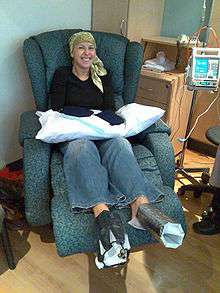Breast cancer chemotherapy

Breast cancer chemotherapy refers to the use of cytotoxic drugs (chemotherapy) in the treatment of breast cancer.
Types
There are three major types of chemotherapy.
- Neoadjuvant chemotherapy
- given before surgery to shrink the size of a tumor
- Adjuvant chemotherapy
- given after surgery to reduce the risk of recurrence
- Palliative chemotherapy
- used to control (but not cure) the cancer in settings in which the cancer has spread beyond the breast and localized lymph nodes. See metastatic breast cancer.
- Combined therapies
- combining, for example, non-drug treatments with localized chemotherapy to limit toxocity and achieve better results
Regimens
Multiple chemotherapeutic agents may be used in combination to treat patients with breast cancer.[1] Determining the appropriate regimen to use depends on many factors; such as, the character of the tumor, lymph node status, and the age and health of the patient. In general, chemotherapy has increasing side effects as the patient's age passes 65.
The following is a list of commonly used adjuvant chemotherapy for breast cancer:
- CMF: cyclophosphamide, methotrexate, and 5-fluorouracil given 4-weekly for 6 cycles
- FAC (or CAF): 5-fluorouracil, doxorubicin, cyclophosphamide given 3-weekly for 6 cycles
- AC (or CA): Adriamycin (doxorubicin) and cyclophosphamide given 3-weekly for 4 cycles
- AC-Taxol: AC given 3-weekly for 4 cycles followed by paclitaxel given either 3-weekly for 4 cycles or weekly (at a smaller dose) for 12 weeks
- TAC: Taxotere (docetaxel), Adriamycin (doxorubicin), and cyclophosphamide given 3-weekly for 4-6 cycles
- FEC: 5-fluorouracil, epirubicin and cyclophosphamide given 3-weekly for 6 cycles
- FECD: FEC given 3-weekly for 3 cycles followed by docetaxel given 3-weekly for 3 cycles
- TC: Taxotere (docetaxel) and cyclophosphamide given 3-weekly for 4 or 6 cycles
- Dose dense regimen: Some of the regimens above (e.g. AC followed by paclitaxel) may be given in a shorter period (i.e. every 2 weeks instead of every 3 weeks).
- In addition to chemotherapy, trastuzumab may also be added to the regimen depending on the tumor characteristics (i.e. HER2/neu status) and risk of relapse. It is usually given either 3 weekly or weekly for a total duration of 1 year.
Since chemotherapy affects the production of white blood cells, granulocyte colony-stimulating factor (G-CSF) is sometimes administered along with chemotherapy. This has been shown to reduce, though not completely prevent, the rate of infection and low white cell count. Most adjuvant breast cancer chemotherapy regimens do not routinely require growth factor support except for those associated with a high incidence of bone marrow suppression and infection. These may include chemotherapy given in the dose dense fashion i.e. 2-weekly instead of 3-weekly or TAC chemotherapy (see above).
Anthracylines
New discovery: By conducting a meta-analysis of four large breast cancer trials including nearly 3,000 patients, the researchers have discovered that an abnormality on chromosome 17, called CEP17, is associated with a worse outcome for patients, but also that its presence is a highly significant indicator that the tumour will respond to anthracyclines.
CEP17 is detected by a common and straightforward test (fluorescent in situ hybridisation or FISH), which is carried out routinely in breast cancer patients; it is used to test for the HER2 gene to see whether the women might benefit from the drug Herceptin. Prof Bartlett said that assessment for CEP17 could be easily carried out in the same FISH analysis as for HER2.
See also
References
- ↑ von Minckwitz, G (March 2007). "Docetaxel/anthracycline combinations for breast cancer treatment". Expert Opinion on Pharmacotherapy 8 (4): 485–495. doi:10.1517/14656566.8.4.485. PMID 17309343.